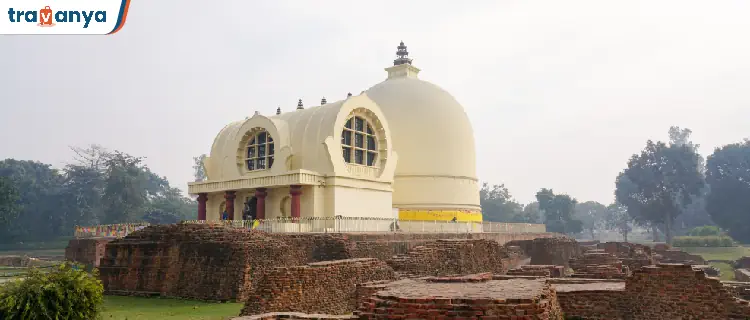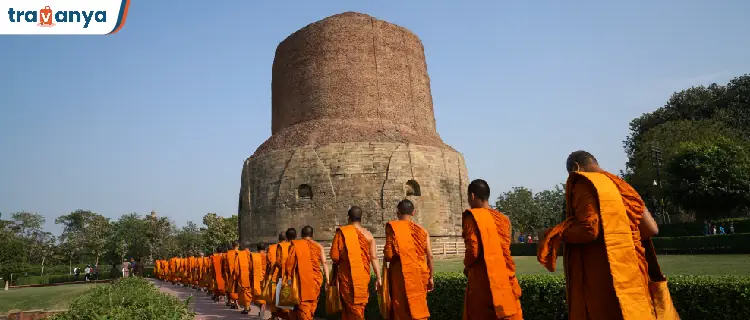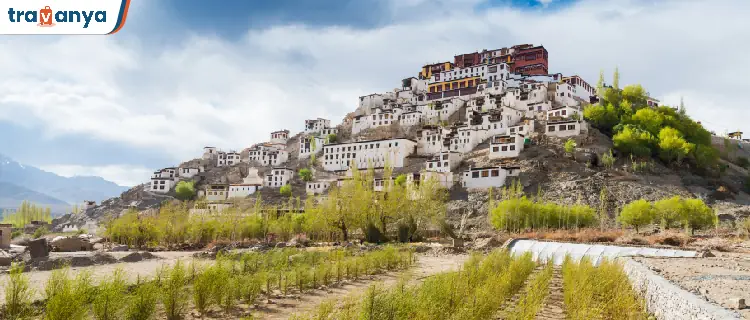
10 Famous Buddhist Temples in India You Should Visit!
Posted on Friday, May 16th, 2025 by Neha Sharma Leave a Comment
Remember that feeling of complete calm you had on your last vacation…or was it even earlier than that? It’s easy to lose touch with the peace within. Sometimes, a change of scenery is all you need to reconnect. If you’re craving peace, look no further than the beautiful Buddhist temples across India. Want to find that inner stillness? Pack your bags & prepare to be amazed: these 10 temples are waiting to welcome you.
1. Mahabodhi Temple, Bodh Gaya, Bihar

The Mahabodhi Temple stands as a beacon of spiritual enlightenment, marking the very spot where Siddhartha Gautama attained Buddhahood under the sacred Bodhi Tree. Originally established by Emperor Ashoka in the 3rd century BCE, the current structure dates back to the 5th-6th century CE.
This UNESCO World Heritage Site is characterized by its towering pyramidal spire, intricate carvings, & the revered Vajrasana or “Diamond Throne.”
Pilgrims from around the world flock here to meditate and pay homage to the Enlightened One. The pilgrims from around the world flock here to meditate & play.
| Feature | Description |
| Bodhi Tree | A direct descendant of the original tree under which Buddha meditated. |
| UNSCO Status | Declared a World Heritage Site in 2002 |
| Daily Rituals | Hosts daily chants and meditation sessions led by international monks. |
| Architectural Style | Exemplifies Gupta period architecture with influences from various cultures. |
2. Mahaparinirvana Temple, Kushinagar, Uttar Pradesh

This temple is situated in Kushinagar. The Mahaparinirvana Temple commemorates the place where Lord Buddha attained Mahaparinirvana (final nirvana) after his demise. The temple houses a 6.1-meter-long reclining statue of Buddha, carved from monolithic sandstone, depicting his serene transition into nirvana. Surrounded by gardens & ancient ruins, the temple offers a peaceful environment for reflection & devotion.
| Feature | Description |
| Reclining Buddha Statue | Dates back to the 5th century CE, and was discovered in 1876. |
| Pilgrimage Significance | Attracts thousands during Buddha Purnima for commemorative ceremonies. |
| Archaeological Importance | Part of the Buddhist Circuit promoted by the Ministry of Tourism. |
3. Ramabhar Stupa, Kushinagar, Uttar Pradesh

Located near the Mahaparinirvana Temple, the Ramabhar Stupa is believed to be the cremation site of Lord Buddha. This 49-foot-high stupa, constructed over a large mound, stands as a solemn monument marking the final rites of the Enlightened One. The simplicity of the structure underscores its profound spiritual significance.
| Feature | Description |
| Alternative Name | Also known as Mukutbandhan Chaitya |
| Historical Excavations | Archaeological digs have revealed ancient brick structures beneath the stupa. |
| Pilgrimage Practices | Devotees perform circumambulation as a mark of respect. |
4. Wat Thai Temple, Kushinagar, Uttar Pradesh

The Wat Thai Temple, constructed by the Thai government, is a symbol of international Buddhist solidarity. Reflecting traditional Thai architectural aesthetics, the temple features golden-tipped roofs, intricate carvings, and serene gardens. It serves both as a place of worship and a center for cultural exchange between India and Thailand.
| Feature | Description |
| Cultural Significance | Built to commemorate King Bhumibol Adulyadej’s accession to the throne. |
| Festivals Celebrated | Hosts Thai festivals and ceremonies, fostering cultural ties. |
| Meditation Facilities | Offers meditation halls and accommodations for visiting monks and pilgrims. |
5. Dungeshwari Cave Temples, Gaya, Bihar

Nestled in the hills near Bodh Gaya, the Dungeshwari Cave Temples are believed to be the site where Siddhartha Gautama practiced severe asceticism before attaining enlightenment. The caves house statues of a fasting Buddha, symbolizing his intense penance. The serene ambiance of the caves provides an ideal setting for meditation and introspection.
| Feature | Description |
| Historical Relevance | Marks the transition of Buddha from extreme austerity to the Middle Path. |
| Pilgrimage Route | Often included in the Buddhist pilgrimage circuit in Bihar. |
| Natural Surroundings | Located amidst peaceful hills, enhancing the meditative experience. |
6. Dhamek Stupa, Sarnath, Uttar Pradesh

The Dhamek Stupa in Sarnath marks the spot where Lord Buddha delivered his first sermon, setting in motion the Wheel of Dharma. This massive cylindrical structure, adorned with intricate carvings, stands as a testament to this pivotal moment in Buddhist history. The surrounding area is filled with ancient ruins & monasteries, reflecting Sarnath’s significance as a major Buddhist center.
| Feature | Description |
| Historical Significance | Built initially in 249 BCE by Emperor Ashoka, later expanded in 500 CE. |
| Architectural Details | Stands at 43.6 meters high and 28 meters in diameter. |
| Nearby Attractions | Close to the Sarnath Archaeological Museum, Housing important relics. |
7. Nalanda Mahavihara, Nalanda, Bihar

Nalanda Mahavihara was an ancient center of learning & one of the world’s first residential universities. Established in the 5th century CE, it attracted scholars from across Asia. The extensive ruins include stupas, monasteries, & temples, reflecting the grandeur of this historic institution. Nalanda played a crucial role in the development of Mahayana Buddhism.
| Feature | Description |
| UNESCO World Heritage Site | Recognized for its historical and educational significance. |
| International Influence | Attracted students from Tibet, China, Korea, and Central Asia. |
| Destruction | Suffered decline after invasions in the 12th century. |
8. Thiksey Monastery, Leh, Ladakh

Perched atop a hill in the Indus Valley, Thiksey Monastery is one of the largest & most architecturally impressive monasteries in Ladakh. Resembling the Potala Palace in Lhasa, Tibet, it has numerous stupas, statues, and thangkas. The monastery is known for its 15-meter-high statue of Maitreya Buddha, the largest in Ladakh.
| Feature | Description |
| Annual Festival | Hosts the Gustor Festival, featuring sacred mask dances. |
| Monastic Education | Function as a center for Buddhist learning and meditation |
| Tourist Attraction | Offers panoramic views of the surrounding valley. |
9. Namdroling Monastery (Golden Temple), Bylakuppe, Karnataka

Namdroling Monastery, also known as the Golden Temple, is the largest teaching center of the Nyingma lineage of Tibetan Buddhism in the world. Established in 1963 by His Holiness Pema Norbu Rinpoche, the monastery is home to over 5,000 monks & nuns. The temple’s ornate architecture, vibrant murals, and golden statues make it a visual and spiritual delight.
| Feature | Description |
| Educational Programs | Offers comprehensive Buddhist education and monastic training |
| Cultural Hub | Hosts various Tibetan festivals and ceremonies. |
| Visitor Experience | Welcomes tourists and provides insights into Tibetan monastic life. |
10. Ghoom Monastery, Darjeeling, West Bengal

Ghoom Monastery, officially known as Yiga Choeling Monastery, is the oldest Tibetan Buddhist monastery in Darjeeling. Established in 1850, it houses a 15-foot-high statue of Maitreya Buddha. The monastery’s collection of rare Buddhist manuscripts & its serene ambiance make it a significant spiritual site in the region.
| Feature | Descriptipon |
| Architectural Style | Reflects traditional Tibetan design elements |
| Cultural Importance | Plays a pivotal role in the spiritual life of the local Buddhist community. |
| Accessibility | Easily reachable from Darjeeling town, it attracts numerous visitors. |
FAQs
Q: What is a Buddhist monastery?
A: A: A Buddhist monastery is a residence for monks or nuns who dedicate their lives to the study & practice of Buddhism. It often includes places for meditation, chanting, and teaching. These monasteries can be temples as well, but their primary purpose is to support monastic life.
Q: What is the difference between a Buddhist temple and a monastery?
A: A: A Buddhist temple is typically a place of worship where devotees gather for prayer & offerings. A monastery, on the other hand, is a living space for monks & nuns who follow a monastic life. Many monasteries also function as temples, but their core focus is on spiritual practice.
Q: Where is the largest Buddhist monastery in India located?
A: A: The largest Buddhist monastery in India is located in Tawang, Arunachal Pradesh. The Tawang Monastery is one of the largest in Asia & is known for its scenic beauty & historical significance.
Q: What is the oldest Buddhist monastery in India?
A: A: The oldest Buddhist monastery in India is the Bavikonda Ancient Buddhist Monastery, located in Andhra Pradesh. This historic site dates back to the 3rd century BCE & holds important archaeological & cultural significance.
Q: How can I join a Buddhist monastery in India?
A: A: To join a Buddhist monastery in India, you need to follow a path of spiritual dedication. Many monasteries offer training programs, & some even have ordination ceremonies for individuals interested in becoming monks or nuns. The process involves meditation, discipline, & a commitment to Buddhist teachings.
Q: What is the largest Buddhist monastery in the world?
A: A: The largest Buddhist monastery in the world is the Hemis Monastery in Ladakh, India. Known for its grandeur and beauty, it is one of the most famous Tibetan monasteries in India.
Q: What is the best Buddhist monastery in India?
A: A: The best Buddhist monastery in India depends on what you’re looking for. Some popular ones include the Tawang Monastery, Rumtek Monastery in Sikkim, & the Sarnath Buddhist Monastery in Uttar Pradesh.
Q: Can I visit Buddhist monasteries in Dehradun?
A: A: Yes, Dehradun is home to several important Tibetan monasteries, such as the Tibetan Buddhist Monastery & the Mindrolling Monastery, both of which welcome visitors to experience Tibetan Buddhist culture.
Q: Where can I find the biggest monastery in India?
A: A: The biggest monastery in India is the Tawang Monastery in Arunachal Pradesh. It spans over 135 acres & stands at an altitude of 10,000 feet, making it the largest in India & one of the largest in Asia.
Q: What are some famous Buddhist monasteries in India?
A:
- A: Some of the most famous Buddhist monasteries in India include:
- Tawang Monastery, Arunachal Pradesh
- Rumtek Monastery, Sikkim
- Bodh Gaya Monastery, Bihar
- Sarnath Monastery, Uttar Pradesh
- Dehradun Tibetan Monastery, Uttarakhand
For detailed travel advice, bookings, or any queries related to monastery visits and local guidelines, connect with our experts at +91-869-999-5345.
At Travanya, we’re here 24×7 to help you plan a peaceful, hassle-free spiritual trip to India’s most revered Buddhist temples.
About Neha Sharma View All Posts
Neha Sharma, a passionate travel blogger, captures the beauty of the world through her words. With her adventurous spirit and a keen eye for detail, Neha takes her readers on mesmerizing journeys to exotic destinations. Her vivid descriptions and insightful tips make her the go-to guide for wanderlust seekers. Join Neha as she explores the globe, sharing her love for travel and inspiring others to go on their unforgettable adventures.


Leave a Comment